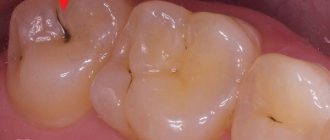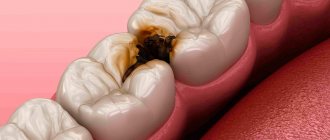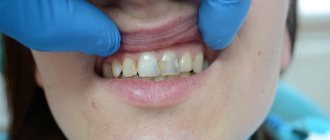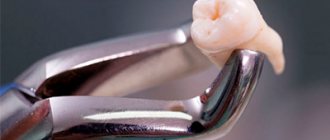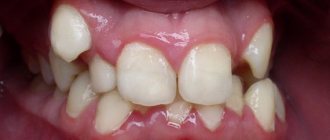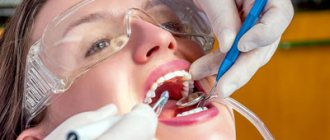From this article you will learn:
- why does bleeding occur after tooth extraction,
- If a tooth is pulled out, the blood won't stop - quick help at home.
The article was written by a dental surgeon with more than 19 years of experience.
Situations where blood bleeds after tooth extraction most often occur when the patient has high blood pressure (due to hypertension or severe stress), as well as if a large vessel was damaged during surgery.
Most often, bleeding develops while still in the dentist’s chair (immediately after tooth extraction), but sometimes bleeding can be delayed, i.e. develops only a few hours or overnight after removal. In the latter case, patients often passively wait for the bleeding to stop on its own, and this can sometimes lead to significant blood loss and weakness.
Bleeding after tooth extraction: before and after photos
How long does bleeding occur after tooth extraction (normal) - normally, bleeding should stop within the first minute after extraction, as soon as the hole fills with blood. However, during the first time, ichor may be released from the wound (do not confuse it with blood), and do not be alarmed if the saliva turns reddish at first - this is normal.
Why doesn't the bleeding stop after tooth extraction?
To know how to stop bleeding after tooth extraction, you need to understand the reasons for the development of bleeding in a particular patient. We will talk specifically about secondary bleeding that occurs after the patient comes home. They usually appear within 8-12 hours (from the moment of removal). There are the following 3 groups of reasons...
- Systemic reasons – firstly, bleeding can be caused by taking aspirin during the week before the removal, or when the patient took it for pain relief immediately after the removal. You cannot take it, because... it reduces blood clotting. Secondly, bleeding can be caused by taking anticoagulants, or if you have a blood disease (associated with a defect in the blood cells “platelets”).
Women often do not stop bleeding after tooth extraction due to increased concentrations of estrogen in the blood. This can be either due to menstrual periods, or due to taking contraceptives. An increased concentration of estrogen leads to degradation and destruction of the blood clot in the socket (this process of clot degradation is called fibrinolysis).In addition, high blood pressure, which is always present against the background of hypertension, or appears briefly against the background of stress, can also be causes of bleeding.
- Failure to follow the doctor’s recommendations - if the patient does not refuse heavy physical activity in the first days after removal - this can lead to bleeding (24stoma.ru). If the patient rinses the mouth too intensively and rinses out the blood clot, this can lead to bleeding, as well as after picking at the wound with the tongue or foreign objects, etc. To avoid this, read the list of recommendations after deletion.
- Local factors - bleeding can develop due to severe trauma to the blood vessels during the removal process (especially if it was complex and was accompanied by a cut in the gum).
Thus, if the doctor severely injured the bone and gums, bleeding can be expected. Often a predisposing factor to bleeding is a purulent infection in the socket of an extracted tooth - when the tooth is removed due to inflammation. Pathogenic bacteria release toxins, which (like estrogens in women) lead to fibrinolysis of the blood clot, i.e. to its destruction.
Bleeding after tooth extraction: video
The video below shows a young man who developed bleeding 6 hours after a tooth extraction. As you will see, a massive blood clot formed above the hole of the extracted tooth, which was removed by hand. If such a clot has formed, it really needs to be removed, but it is better to do this with a sterile gauze swab. After this, you need to make another tight swab from a sterile bandage, place it on the hole and bite firmly.
Causes and symptoms of oral sepsis
The cause of oral sepsis can be the above microorganisms: staphylococcus, E. coli and streptococcus, as well as toxins and breakdown products of certain tissue proteins.
This type of sepsis usually begins in the tonsil area and results from periodontal disease.
Oral sepsis has the same symptoms as any other type of sepsis. For example, symptoms may include the following:
- very rapid fatigue of the body and the feeling that a person cannot get enough sleep;
- general weakness and constant headache;
- leukocytosis and lymphocytosis;
- unusual body temperature for a person - too high or, conversely, too low;
- increase in ESR;
- small inflammatory areas, a test of which indicates the presence of sepsis.
Sepsis is a disease that can last only a few hours, however, in some cases, this type of disease can last for several days, months and even years. Oral sepsis is precisely the form of the disease that lasts for quite a long period, and that is why doctors in St. Petersburg often call it chronic.
How to stop bleeding after tooth extraction -
If you have a tooth pulled out, the bleeding does not stop: what to do will depend on how much bleeding there is. Those. The first thing you must do is assess the severity of the situation. If the bleeding is really severe, then it is best not to wait until it stops on its own (this may not happen), but to contact a dental surgeon to apply sutures to the socket of the extracted tooth.
You can go to any 24-hour private dentistry, or to the emergency room of an Emergency Hospital or Regional Clinical Hospital (the latter always have a doctor on duty). When contacting government agencies, do not forget to take your medical insurance and passport with you. If you don’t have a policy with you, then you are required to provide emergency assistance without it (and free of charge), but, as a rule, difficulties arise with this.
Important: if bleeding is associated with the presence of systemic factors, then any local means to stop bleeding (which we will discuss below) will not be effective enough in this group of patients. For example, this applies to women (while menstruating or taking contraceptive medications), patients with bleeding disorders, blood disorders, and patients who have recently taken aspirin or anticoagulants.
And this also applies to patients with high blood pressure. So, all these groups of patients need professional help from a dental surgeon (socket tamponade and/or suturing of the extracted tooth socket).
How to stop bleeding from a hole at home -
How to stop bleeding after tooth extraction, if it is not very strong: first, you need to remove thick blood clots from the oral cavity using the desired sterile gauze swab (it can be made from a sterile bandage). After that, the following remedies can help you...
- Tamponade of the socket - also make a very tight gauze swab from a sterile bandage, place it over the socket of the extracted tooth and bite firmly. You need to clench your teeth so tightly that you feel that the tampon fits tightly to the wound surface (but without causing pain).
- Place the ice on your cheek (Fig. 4) –
Wrap snow, ice or a piece of frozen meat from the freezer in a plastic bag and a thin towel. The ice pack should be placed against the surface of the face, which is located in the projection of the extracted tooth. Usually the ice is kept 3-4 times for 5 minutes (at 5-10 minute intervals).
- Measure your blood pressure - if your blood pressure is high, take a blood pressure lowering medication. If you don’t have a blood pressure measuring device, most likely your elderly neighbor does. In addition, almost any pharmacy will measure your blood pressure completely free of charge, and will also recommend a drug to lower your blood pressure.
- Hemostatic sponge after tooth extraction - if tamponade of the socket does not help, then you can buy a hemostatic sponge at the pharmacy and place it in the upper part of the socket, then immediately place a gauze swab on top of the socket and bite it tightly. If the sponge is actually placed inside the hole, then the bleeding decreases/stops almost instantly.
How to do this - first remove the blood clots on top of the hole, cut off a fairly large fragment of the sponge (2x2 cm), and try to push the sponge into the hole with clean tweezers. A large fragment of a sponge is taken because when soaked in blood, the sponge immediately becomes several times smaller. After this, bite the tampon tightly and press the ice to your cheek for 5-10 minutes.It’s more convenient when you don’t put the sponge on yourself, but on your relative (or a nurse you know at the entrance). Keep in mind that when the sponge gets wet with blood, it immediately becomes soft and can be difficult to insert into the hole. In this case, you can cut off a new piece of sponge and try to insert it into the hole again.
- Taking the drug "Ditsinon" (analogue - Etamzilat) is a hemostatic drug in tablets of 250 mg. The drug begins to act approximately 30 minutes after administration, but a pronounced hemostatic effect develops after approximately 2-3 hours. A single dose for adults should be no more than 250-500 mg. The drug should not be used in people with a tendency to thrombosis, thromboembolism, or thrombophlebitis (read the instructions for use carefully).
If none of the above helps -
If nothing helps, and if you feel weak and dizzy, then you shouldn’t wait any longer. It is necessary to urgently consult a doctor.
- The best option in the conditions of Russian free healthcare is to take a taxi to the nearest 24-hour private dental clinic, where you will get stitches. If you feel weak, then do not drive yourself unless you want to get into an accident. For anesthesia, 2 stitches and a hemostatic sponge you will have to pay approximately 750-1000 rubles.
- Feel free to call an ambulance - when talking to the ambulance dispatcher, complain not only about bleeding, but also about severe dizziness and weakness. With such symptoms, an ambulance will definitely arrive. Usually they will first try to stop the bleeding using tampons with peroxide (which a priori cannot help in this situation). Seeing the failure of such therapy, they will be forced to take you to the hospital, where they will put stitches on your wound and send you home.
Suturing the socket: before and after photos
Methods for treating periostitis
In order to properly cure gumboil, you should contact a dentist, who will conduct an examination and prescribe the necessary measures, assessing the patient’s condition.
Today, the inflammatory process is eliminated using various methods:
- Antibiotics.
Such medications are prescribed only by a doctor and are an important step in speeding up recovery. - Physiotherapy.
These are electrophoresis, ultrasound and laser therapy. They are aimed at reducing inflammation and shortening the recovery period. - Therapeutic treatment.
It is carried out if a decision is made to preserve the tooth. The dentist treats and fills the root canals of the tooth, eliminates infection in the gum pockets (if periostitis is caused by periodontitis). - Surgical intervention.
The doctor dissects the periosteum and opens the inflamed lump, after which he installs a drainage to drain the purulent contents. If the crown part is seriously damaged and cannot be restored, the tooth is removed. - Local therapy, rinsing
. To reduce pain, relieve swelling and improve the release of purulent masses, ointments and gels are prescribed and applied to the affected area. Also, if you have a gumboil, you can rinse your mouth with a soda solution, Miramistin, tincture of chamomile, and calendula.
Prevention of bleeding after removal -
First of all, before removing a tooth, you must inform the doctor that you have taken aspirin, coagulants, are on your period, or are taking birth control pills. You should also be warned if you have reduced blood clotting, blood diseases, or high blood pressure. In these cases, the doctor will place a hemostatic sponge in the hole in advance and apply sutures.
In addition, we recommend that you definitely ask your doctor (even before the extraction begins) to put 1-2 stitches on the hole of the extracted tooth, even if you are asked to pay another 300-500 rubles for this pleasure. This applies not only to large multi-rooted teeth, but even to single-rooted teeth. The fact is that stitches will not only prevent possible bleeding...
Studies have shown that applying sutures to reduce the size of the wound can reduce pain after removal by approximately 30-50%, eliminate the loss of a blood clot from the socket, and also reduce the risk of developing inflammatory complications after removal. And also do not forget to follow your doctor's recommendations. We hope that our article on the topic: Pulled out a tooth, how to stop the bleeding - turned out to be useful to you!
Sources:
1. Higher prof. the author’s education in surgical dentistry, 2. Based on personal experience as a dental surgeon, 3. National Library of Medicine (USA), 4. “Outpatient surgical dentistry” (Bezrukov V.), 5. “Propaedeutics of surgical dentistry” (Soloviev M. .).
Tooth flux - what is it?
Periostitis (flux) is a rather unpleasant process that affects soft tissues and periosteum. An inflamed pouch on the gum can form after unprofessional treatment by a dentist, as a result of injury to the mucous membranes or as a consequence of their disease. There are different forms of flux, differing in the localization of inflammation. For example, with serous periostitis, the periosteum becomes inflamed, and infection with diffuse flux affects different parts of the jaw, so the pathology has to be eliminated surgically.

